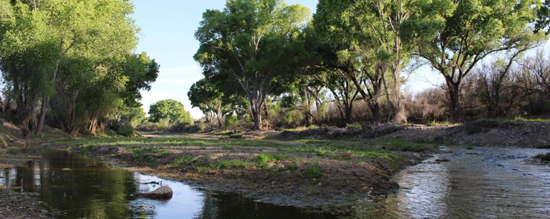
By Victoria Prieskop | Courthouse News Service
In a narrowly defined ruling, the Arizona Court of Appeals on Tuesday vacated and remanded the Arizona Department of Water Resources approval of a 6,900-home development in Sierra Vista, near the last free-flowing river in Southern Arizona.
At issue for the U.S. Bureau of Land Management is the giant development’s effects on the San Pedro River, the last free-flowing river in Southern Arizona, and the San Pedro Riparian National Conservation Area, famous for its hummingbirds.
Created by Congress in 1988, the 36-square-mile Conservation Area is home to 100 species of birds, wintering habitat for another 150 bird species, 84 species of mammals, 41 reptiles and amphibians and 14 species of fish.
Pueblo Del Sol is to provide water to the Tribute Master Planned Community of as many as 6,959 homes in Sierra Vista, 4½ to 5 miles from the San Pedro River. Water for the community is to come from wells, i.e., groundwater.
Citing the size of the development in arid Southern Arizona, the BLM sued the Arizona Department of Water Resources and Pueblo Del Sol Water Company to protect the Conservation Area. It said that Pueblo Del Sol’s groundwater pumping would inevitably interfere with the Conservation Area’s groundwater rights.
The Maricopa County Court agreed, and ruled that the ADWR had to consider the effect of the development’s groundwater pumping on the BLM-administered Conservation Area.
The appeals court was not persuaded by Pueblo Del Sol’s argument that the water it would pump would not actually be groundwater because it was close to the river. Declining water tables are a problem throughout Southern Arizona, and have caused subsidence, or collapse of the land, in places.
Nonetheless, the appeals court ruling was a victory for Pueblo Del Sol and the developers, as the court narrowed considerably the rights of the Bureau of Land Management.
Writing for the panel, President Judge Jon Thompson sided with the ADWR and the water company, that “the superior court erred in its consideration of the definition of legal availability and in requiring ADWR to consider the impact on the Conservation Area.”
The Conservation Area and the planned development sit over the same water table, as does, Sierra Vista, pop. 44,000, and Fort Huachuca, with a base population of about 12,500.
The appeals court ruled that the ADWR need not consider the effects of groundwater pumping for 6,900 homes on the San Pedro River or the Conservation Area.
However, it must consider the effects of the pumping on the BLM’s water rights in the land — which, after 40 years of litigation, have still not been quantified.
Under Arizona law, to approve a housing development, the ADWR must ensure that it will have an “adequate water” supply for 100 years.
Citing Arizona law, Judge Thompson wrote: “‘Adequate water’ is ‘[s]ufficient groundwater, surface water or effluent of adequate quality [that] will be continuously, legally and physically available to satisfy the water needs for the proposed use for at least one hundred years.'” (Emphasis in ruling.)
Thompson upheld the ADWR’s interpretation of “legally available,” but found that it did not “consider BLM’s unquantified federal water rights in determining whether Pueblo has demonstrated the availability of ‘adequate water.'”
The master-planned community, then, must await quantification, though when that may come is anyone’s guess, as there are thousands of claimants to the water.
The narrow ruling, though, certainly gives the developers hope.
Thompson wrote for the panel: “The Department [of Water Resources] is not required to consider separately the potential impact of proposed pumping on area streams or the San Pedro River. Further, ADWR is not required to consider the potential impact of proposed pumping on either the San Pedro Riparian National Conservation Area or on the Conservation Area’s water right.”
What the water department must do is “give educated consideration to the unquantified priority federal reserved water rights of BLM, until such amount is quantified in the General Stream Adjudication for the Gila River System and Source (Gila Adjudication).”
The Gila Adjudication is a state adjudication process involving thousands of claimants that began in the 1970s, involving water rights in the Gila River and Little Colorado River systems. Under even more complex and older federal regulations known as the Law of the (Colorado) River, earlier claimants may have priority in water claims, due to their “existing use” of the water.
The appeals court ruled Tuesday that on remand, the Department of Water Resources must include “the quantified amount” of water granted to the BLM, as caretaker of the Riparian Area, in the Gila Adjudication.”
The length of the litigation and its uncertain endpoint “does not exempt the Department from having to consider BLM’s reserved water right even though that right has not yet been quantified,” Thompson wrote.
Thompson described the San Pedro River, as it “flows from Northern Mexico through Southeastern Arizona for approximately 130 miles until it joins with the Gila River at Winkelman, Arizona. The San Pedro River is one of the few remaining free-flowing and undammed rivers in the desert southwest and it is home to diverse flora and fauna.”
When Congress designated 36 square miles of the San Pedro River basin a Riparian National Conservation Area in 1988, it created a “federal water reserve right for the Conservation Area ‘in a quantity sufficient to fulfill the purpose’ of protecting ‘the riparian area and the aquatic, wildlife, archeological, paleontological, scientific, cultural, educational, and recreational resources of the public lands surrounding the San Pedro River,'” the judge wrote.
The BLM asserted a claim in the Gila Adjudication in 1989, giving it priority dating to that year under federal water rights, and it also has priority in three state claims dating back to 1985.
“The water supporting the Conservation Area is certainly an ‘existing use.’ We see nothing under this regulation which defines ‘existing use’ to exclude federal water claims. Rather, requiring the consideration of BLM’s federal reserved water right fulfills the intent of the groundwater management statutes to protect Arizona’s economy and welfare, and to provide a comprehensive framework for the management and regulation of groundwater, without compromising Congress’s intent to preserve the Conservation Area.”
Appeals Court Judge Patricia Norris and retired Judge Maurice Portley joined Thompson on the panel.
They also vacated the award of $155.861.50 in attorney’s fees to the two private citizens who joined the BLM as plaintiffs.











